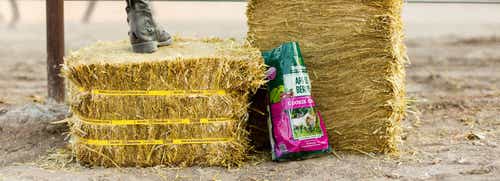
Spring Pasture & Grazing Tips
It’s that time of year when pastures are turning green, and we might be tempted to let our animals out early to enjoy that fresh, lush, green grass. Depending on the location, some animal owners are ready and have had their horse grazing and some might not quite be there yet. No matter the situation, spring pasture grazing is up to the animals and your pasture.
Most horse owners do not have access to enough pasture to solely rely on it as their only source of fiber for their horses. Dry forage or hay may need to be supplemented, while the pasture will be used for some nutritive value, but more for exercise and socialization for horses and to strengthen bones on foals.
In episode 35 of Standlee’s Beyond the Barn® podcast, Dr. Tania Cubitt, Equine Nutritionist, and Katy Starr, Marketing Consultant, have a conversation about spring pasture management, and whether your pasture and horses are ready.
Replenish the Nutrients
Just like a garden or farm, your pasture is growing plants and requires nutrients to be replenished. To maintain a growing and beautiful pasture, we recommend that you test your soil every three years and work with your equine nutritionist and local extension office to ensure that your animals are receiving the best nutrition from your pastures as possible.
Dr. Cubitt states the reason for testing soil from pastures, “we want to make sure that if we have fertilization in our budget, that we're putting exactly what our fields need on and not extraneous other nutrients that are not required…doing a soil test and most of your local extension offices will help you with a soil test…”
When applying the fertilizer, we recommend that you apply half in the early spring, the other half in the early summer months, and always prior to rainfall. Dr. Cubitt also recommends “that you keep the horses off the field until you can no longer see the fertilizer so that it’s sunken into the ground.”
Observe Your Pastures
In the spring, it can be tempting once you see that the grass is turning green to allow your horse and other livestock out to pasture. Taking the time to observe your pastures and allowing them time to grow, can ensure that your pasture can be sustained throughout the rest of the summer months and that the grasses can provide value to the nutrition of your horse and other livestock.
Pasture will be ready for grazing when the grasses reach up to six inches in growth. When horses graze, they tend to pull grass from the roots. Once the grass has grown about six inches above the ground, the roots will become stronger below to maintain the strength of the plant. If pasture grass becomes taller, mowing your pastures can encourage consistent growth and decrease weed growth.
Adjusting Your Feeding Schedule
Going from feeding the majority of your horse’s diet as dry forage to when you first turn your horses out can be considered a rapid feeding change, if not transitioned properly. Gradually introducing horses to spring pasture can help minimize digestive upset. Remember that spring grass is a “cool season” grass, meaning that it is higher in sugars, protein, and moisture.
Because of this change, start by turning your horse out for about fifteen minutes for the first three days. Starting on the fourth day, add thirty minutes each day. Around day 16, your horses should be ready for full turnout. Watch your horse carefully during a rapid feeding change, if you notice any digestive upset – pull back.
As a general rule of thumb, a well-managed pasture can support one thousand-pound horse per two acres of pasture. It needs to have 75% coverage, at least 6 inches in height.
For more information about rotational and multi-species grazing, common toxic weeds to horses, designing an ideal pasture, and more, listen to episode 35 of our Beyond the Barn podcast with Dr. Cubitt and Katy Starr.













